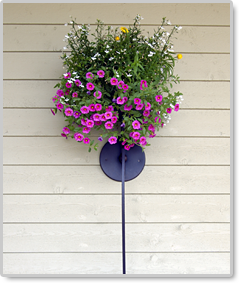Properly Caring For Your Wood Siding

Wood siding expands and contracts with normal changes in humidity and temperature. These fluctuations cause paint to chip and crack, and cause caulked seams to deteriorate around windows, doors, and corners. And because the south and west sides of your home receive the most sun, they will wear faster than the north and east sides, and your siding will need repairs and re-finishing more often on these sides of your home.
It is therefore important that at least once a year you should inspect your wood siding. Inspect your siding for any possible places where water can penetrate or get under the boards: joints with cracked caulking; missing flashing; cracked boards; chipped or peeling paint; open nail holes; and around trim and light fixtures.
PROTECTING
Your wood siding must be properly finished with paint, stain, or clear sealer. Left unprotected, it’s susceptible to rot and decay caused by moisture (helpful accessory: wood paints and seals).
But in addition to being properly finished, there are other things you should do to protect your wood siding. For example, make sure that any soil is at least 8 inches below the bottom of your wood siding, to prevent moisture and insects from infiltrating your wood. And be sure that no bushes, tree branches, shrubbery, etc. are touching your wood siding. These can scratch your siding and create opportunities for insects and moisture to attack your wood. You should always have about 1-2 feet between your house and any plant materials, including crawling vines.
And take care that any lawn sprinklers do not spray water onto your wood siding, especially sprinkler heads which point upwards and can spray water under the edges of your wood siding. And further about your lawn, when mowing your grass, be sure that the mower discharge faces away from your house, so that sticks and stones thrown from the mower do not fly against and damage your siding.
Never let children throw balls against your siding. And if you have problems with woodpeckers, then placing a wind chime nearby can often help keep them away.
You will also want to make sure that your attic has proper ventilation, and maintain your indoor humidity below 65% (helpful accessory: indoor humidity monitors). As high humidity from these areas can cause moisture to get behind your wood siding. And if you are in a region that is prone to ice damming, you should consider adding roof heat tracing wires, to prevent ice build-ups which can cause water to infiltrate behind your wood siding.
CLEANING
Dirt is the most common cause of discoloration on wood siding. You should clean dirt from your siding using warm, soapy water and a soft-bristled brush. Frequently cleaning off dirt and mildew will help your wood siding to last longer. When cleaning your wood siding, work in small sections and always start at the top and work your way down. Be sure to rinse your cleaning solution off the siding before it dries.
Before washing your wood siding, be sure to: turn off power to any outside lights or outlets that may get wet; ensure that all windows are closed tightly; spray away from doors and windows; and if you have shrubbery or flowers nearby, make sure you cover them with plastic so no cleaning solution drips on them.
Natural wood siding that has discolored with age can be restored to its original color by applying a wood cleaner or brightener. These products often are intended for use on wood decks, but they work well on natural wood siding.
Mildew appears on wood siding as black spotty stains. Dab the area with a little diluted bleach, and if the black disappears, then it’s mildew. To clean mildew off of your wood siding, use a solution of one part bleach to four parts water. Scrub the areas with a soft-bristled, long-handled brush. Be sure to wear eye and skin protection, and protect plants from splashes. Rinse thoroughly with clean water. Depending on your type of wood and paint or stain, you may want to consider adding a mildewcide to help prevent mildew from returning.
Rust stains often appear as dark black splotches and vertical streaks. They’re usually caused by a nail or screw that aren't galvanized. To remove the stain, dissolve 4 oz. oxalic acid in 1 cup warm water. Apply the mixture to the stain and gently scrub with a soft bristle brush. Rinse thoroughly with water. Wear eye protection and acid-proof gloves, and avoid splashing the mixture onto adjacent surfaces.
POWERWASHING
You must be extremely careful when using a power washer on your wood siding. The force of the water can strip paint, gouge softwoods, loosen caulk, and drive moisture into even painted surfaces.
When using a power washer, avoid aiming it upward, as this will drive moisture under your wood siding. Always start the spraying action with the sprayer pointed away from the surface, then slowly begin to point the tip towards your siding, until the pressure appears to be the correct strength. Never get closer than 12" from the siding or you may damage it. Use both hands when using a power washer, and never use it while on a ladder. And do not point it at windows.
When power washing, go the full length of the board and not up and down from board to board. Going from board to board causes a patchwork effect that will be unsightly and difficult to correct.
And finally, never power wash your house if you suspect that it may be been painted with lead paint.
REPAIRING
Finish any necessary repairs before cleaning or painting your wood siding. If you find problems with your wood siding or caulking, they should be repaired as soon as possible, as water penetration damage can spread very rapidly.
If a siding board is only slightly warped, it can usually be repaired by driving rust-resistant screws through the boards and into the underlying studs. Be sure to countersink the holes, filling with putty and then painting. Significantly warped boards, however, may require removal and being sanded down with sandpaper, before they can be flattened further down with screws.
If there are holes you need to repair in your wood siding and they are deep, then you should fill the holes in stages, allowing each stage to dry completely before adding the next layer of fill.
Split boards can be repaired by opening the split, applying water-proof glue and then clamping or screwing the two pieces back together (see types, costs, and reviews of water-resistant wood glues). If screwed together, then rust-resistant screws should be used.
When repairing the caulking on your siding, use a color-matched exterior caulk and apply during dry days with temperatures in excess of 65 degrees F for maximum adhesion (helpful accessory: wood caulks).
PAINTING
Wood siding typically needs to be painted every five years and treated or stained every three years, to ensure that it is properly protecting your wood. Choose a product that works best with your home's particular wood and climate. Better quality paints and stains that last longer are good value, versus cheaper products which don't last as long (helpful accessory: wood paints). How long your paint or stain will last for your wood siding will depend on the quality of the surface preparation, the coating material, the type of siding, and the climate. Staining of your wood siding should be done in accordance with your particular type of wood, and the manufacturer's recommendation for the stain or clear sealer that you are using. Paint your house with lighter colors to reflect more of the sun’s heat if you live in a hotter climate, but darker-colored if you live in a colder climate.
Before you paint your wood siding, all dirt and paint chips should be removed using a wire brush or scraper. The surface should be clean and smooth, and if there are loose fibers, sandpaper should be used to smooth these areas. Dust the surface before applying a primer. Allow the primer to dry completely, and then apply several thin coats of paint (see types, costs, and reviews of wood primers). Never apply paint or stain over mildewed areas, as this will cause blistering and discoloration.
Related Articles . . .
Taking Care of Your Brick Siding
Brick siding can give a home a stately appearance, and for most homes, brick siding requires significantly less maintenance than wood siding. However this does NOT mean NO maintenance.
Protecting and Cleaning Your Vinyl Siding
Since vinyl siding never needs painting, it might be easy to assume that this means that your vinyl siding is indestructible and requires no maintenance. But unfortunately, this is not the case.
Pest Control Advice from an Industry Insider
This article and video provides pest control advice from the owner of a pest and wildlife company, and describes keeping out pests, what to look for when hiring a professional, and what can go wrong.
Why You Need to Keep Rain Away From Your Foundation
Your home's gutters and downspouts play a very important role in protecting your home's foundation from water damage. This article explains why and how you should take care of your home's gutters and downspouts.
Is It Time to Replace My Roof?
Most asphalt roofs have a lifespan of 15-25 years, but this can vary significantly based on a variety of factors. So how can you tell if your roof needs to be replaced sooner, before damage to your home starts?









